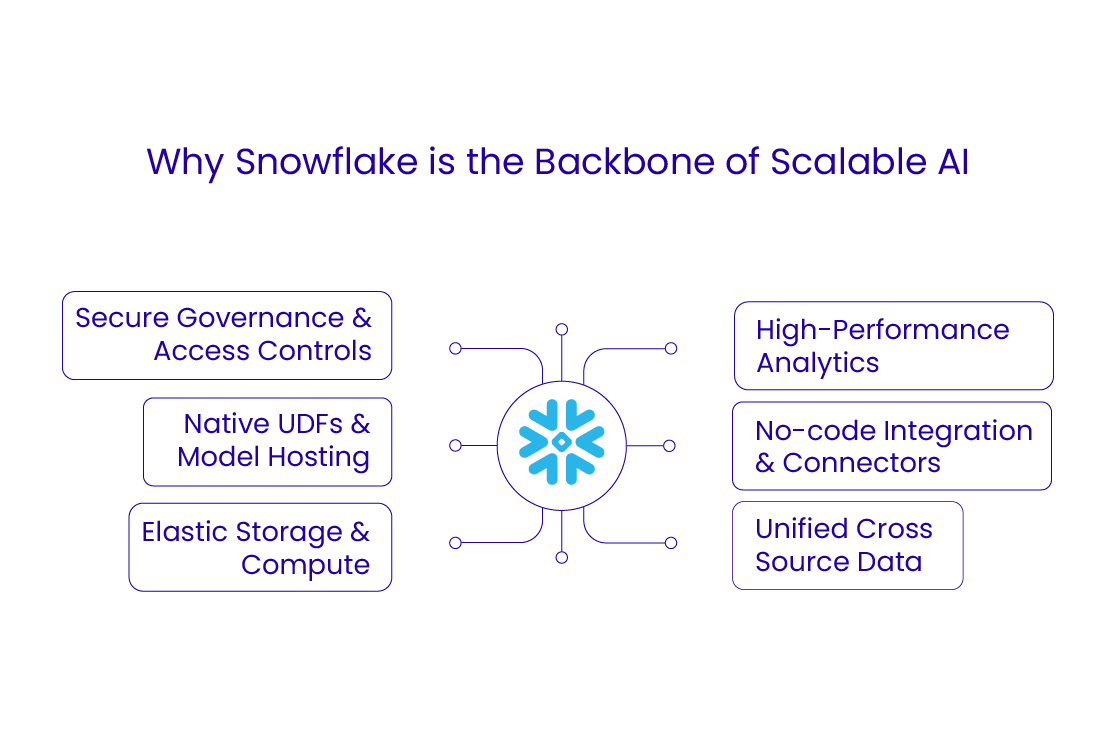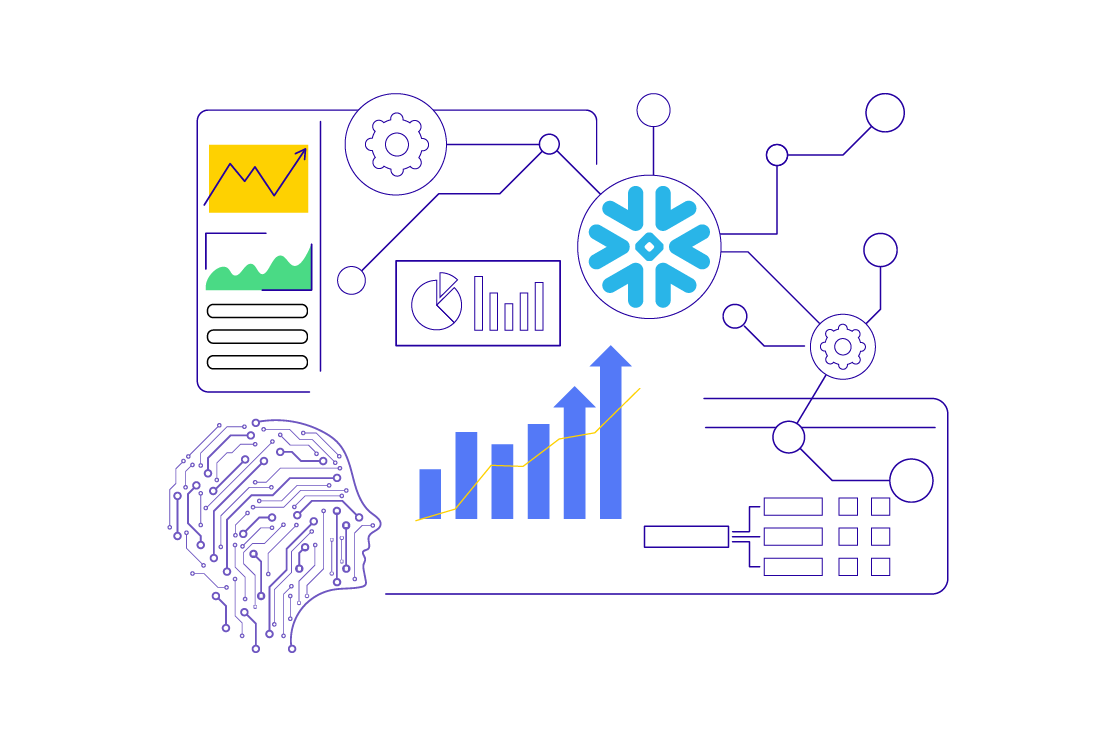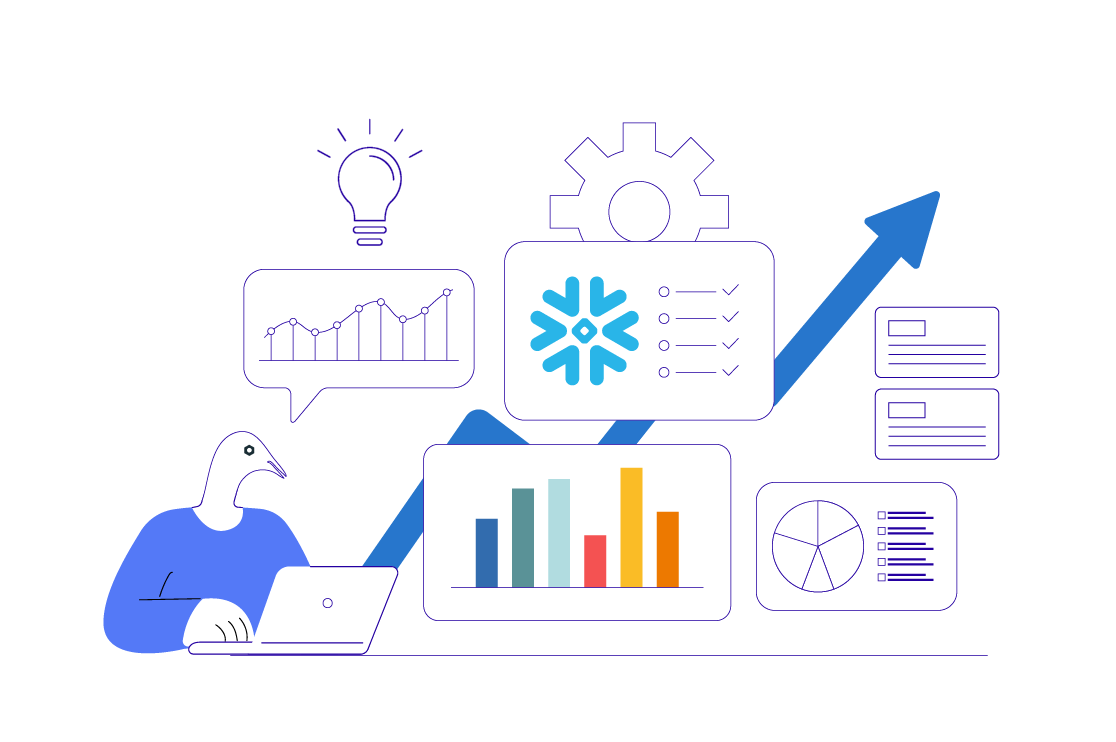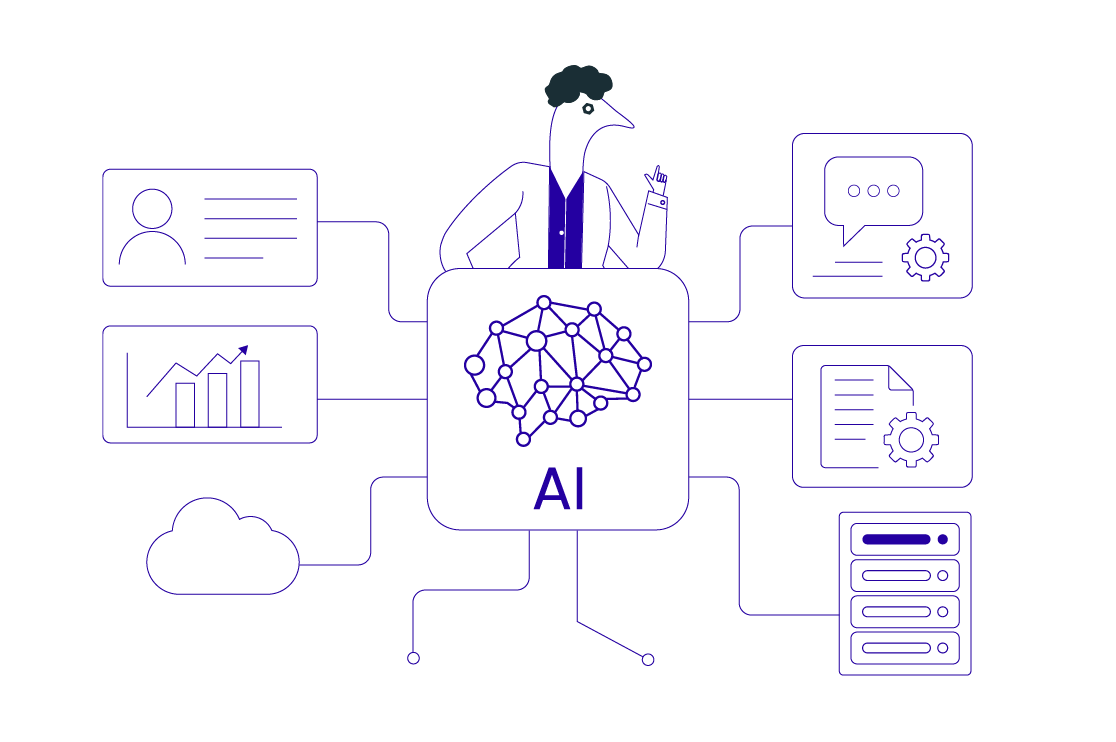Are your AI pilots stuck in an endless loop of experiments with unpredictable ROI?
Is your enterprise data scattered in silos, slowing down real-time insights & decision-making?
And how do you plan to scale AI across the organization without sending infrastructure costs going haywire?
For CXOs, these are not IT challenges. They are strategic barriers to growth. The enterprises leading in AI today are not the ones spending the most on infrastructure, but the ones who have built a scalable, governed, and unified data foundation.
Table of Contents
Why Snowflake is the Backbone of Scalable AI
Unlike traditional platforms, Snowflake AI Strategy separates compute and storage, allowing you to scale resources on demand without ballooning costs. This means you can:
-
Run AI experiments at low cost.
-
Scale to enterprise-wide AI deployment without infrastructure bottlenecks.
-
Deliver faster insights and ROI with a unified data ecosystem.
Snowflake AI offers a unified platform for different types of data (structured, unstructured, and semi-structured), along with integrated data sharing potentials and built-in AI services. Implementing Snowflake for your AI models is the ideal strategy to ensure consistency performance and acceleration in deployment of AI applications.

Key reasons to know why Snowflake is critical for a Proper AI Model
-
Scalable compute and storage: Snowflake’s core innovation separates data storage from compute resources, allowing for independent scaling. The compute resources can be instantly scaled up or down to match the demands of AI workloads, from small experiments to large-scale model training, without impacting data storage.
-
Unified data platform: Snowflake AI Strategy supports structured, semi-structured (like JSON), and unstructured data within a single system, simplifying data pipelines for AI. By consolidating data, it provides a single source of truth and reduces complexity, which is crucial for building robust AI models.
-
Developer-friendly environment: It supports various programming languages, including SQL, Python, and Java through Snowpark, making it accessible to a wide range of users. The platform offers secure access to industry-leading large language models (LLMs) and other AI services, directly integrated into the data platform.
-
High performance & agility: Snowflake’s architecture is optimized for high-performance computing, ensuring efficient processing of massive datasets for AI applications. The ability to scale resources instantly and manage diverse workloads concurrently provides the operational agility needed to adapt to evolving AI requirements.
Embedded AI/ML: Models Built Right Inside Snowflake AI Strategy
Snowflake offers a powerful platform for building, deploying, and managing AI and Machine Learning (ML) models directly within its secure Data Cloud environment.
Here’s how Snowflake supports embedded AI/ML:
-
Snowflake AI Cortex: Snowflake Cortex AI offers access to LLMs through SQL or Python functions, enabling tasks like summarization, translation, sentiment analysis, and text generation.
-
Snowflake ML: It offers the relevant functionality for developing customer machine learning models through open-source libraries like PyTorch, XGBoost, and scikit-learn within Snowflake’s environment.
-
Snowpark ML: It is a dedicated set of tools within the Snowpark ecosystem specifically for building and deploying ML models. It provides APIs for data preprocessing, feature engineering, model training, and deployment, all without moving data outside Snowflake.
Benefits of building ML models inside Snowflake
-
Security and Governance: Data remains within Snowflake’s secure perimeter, benefiting from existing role-based access control and governance policies.
-
Performance and Scalability: Leverages Snowflake’s elastic compute resources for efficient data processing, model training, and inference.
-
Simplified Operations: Eliminates the need to manage separate ML platforms or move data between systems, streamlining the MLOps lifecycle.
-
Accessibility: Offers both SQL-based ML functions for analysts and Python APIs for data scientists, democratizing access to AI/ML.
-
Cost Efficiency: With pay-as-you-go pricing, users only pay for the resources consumed during model development and deployment.
By embedding AI/ML capabilities directly into the Data Cloud, an effective Snowflake AI strategy empowers organizations to unlock insights from their data more quickly, securely, and efficiently, enabling a wide range of use cases across various industries.
Recommended Reading:
- Snowflake Cortex AI: How Enterprises Can Scale AI Workflows with Confidence
- Snowflake Cortex Agents: Scalable AI for Enterprise Data Insights
- Generative AI & Snowflake: How it is Driving the No-Code AI Future?
- AI App Development with Snowflake: Understanding the Enterprise Shift to AI-Powered Applications
Industry Specific Use Cases of Snowflake AI
Snowflake AI Strategy in the Telecom Industry
The telecom industry thrives on massive, fast-moving datasets from call detail records, customer interactions, IoT devices, and 5G infrastructure. Snowflake & AI convergence empowers telecom providers to shift from reactive to predictive and autonomous operations.
Key Use Cases:
With Snowflake’s centralized customer 360 view and AI-powered predictive models, telcos can identify customers at risk of churn and proactively offer personalized retention campaigns.
AI models trained directly within Snowflake can analyze real-time IoT sensor data from towers and routers to predict failures, optimize bandwidth allocation, and reduce downtime.
Detect SIM card fraud, fake KYC identities, and unusual usage patterns by combining Snowflake’s scalable data sharing with AI-driven anomaly detection.
By consolidating siloed call records, CRM data, and network usage into Snowflake’s unified platform and embedding AI churn models directly in the Data Cloud, they:
-
Identified high-risk customers 3 months in advance
-
Launched personalized retention offers
-
Reduced churn by 22% in the first year
With Snowflake Cortex AI or embedded ML models, telecoms can deploy AI-driven recommendations in real time—upselling premium data packs or optimizing customer support resolution.
Snowflake AI Strategy in the Manufacturing Industry
Manufacturing is evolving wherein data and AI transform plants into intelligent, self-optimizing systems. Snowflake acts as the data backbone, and AI amplifies decision-making.
Key Use Cases:
Using Snowflake’s time-series storage of IoT machine data, AI can forecast equipment failures and prescribe optimal maintenance windows—cutting unplanned downtime.
With AI models embedded in Snowflake, manufacturers can run multi-variable forecasting (weather, logistics delays, market trends) for precise demand planning and just-in-time inventory.
Manufacturing defect detection improves when computer vision data is stored, integrated, and analyzed in Snowflake. AI models flag anomalies faster, reducing product recalls and wastage.
AI-driven analytics within the Snowflake AI strategy can optimize energy usage, reduce material waste, and enable compliance reporting on ESG metrics. Using IoT sensor data stored in Snowflake and AI-driven predictive maintenance models, they:
-
Predicted equipment failures 2 weeks in advance
-
Scheduled optimal maintenance windows
-
Reduced unplanned downtime by 35%, saving $15M annually
To summarize, it’s apt to state that Snowflake provides a governed data foundation, while AI converts that data into actionable intelligence, helping Telecom and Manufacturing enterprises move toward real-time, predictive, and autonomous operations.
CXO takeaway: With the right Snowflake and AI implementation strategies, companies can easily accomplish around 57% faster AI model training.
Strategic Recommendations for Data Architecture
A well-designed data architecture is crucial for organizations seeking to derive maximum value from their data assets. It serves as the blueprint for managing data effectively, aligning data management with organizational strategy and objectives.
Here are 7 key strategic recommendations to guide your data architecture development:
-
Align data architecture with business strategy
-
Design for scalability and flexibility
-
Embrace modern architectural patterns
-
Foster a culture of collaboration
-
Plan for continuous review and refinement
By implementing these strategic recommendations, organizations can build robust and secure data architectures that effectively manage their data assets, empower data-driven decision-making, and unlock new opportunities for growth and innovation.
Conclusion
In today’s digital economy, data without AI is underutilized capital. But AI without the right foundation is costly, siloed, and unsustainable.
Snowflake bridges this gap. It gives you:
-
Scalability of cloud economics.
-
Speed of embedded AI.
-
Assurance of enterprise-grade governance.
As a CXO, your decision is clear: standardize Snowflake enterprise AI as your organization’s backbone. Start small with embedded AI pilots, expand across functions, and build an AI-ready data architecture that drives revenue and resilience.
Your enterprise’s AI future depends on the foundation you lay today. With professional Snowflake services, that foundation is already here.
FAQs
What makes Snowflake ideal for scalable AI?Because it unifies storage, compute, AI/ML workflows, and governance in a single cloud-native platform.
How does Snowflake embed AI/ML within its platform?Through Snowflake Cortex (LLMs), Snowpark, ML-powered functions, and APIs that keep models close to the data.
What are Snowflake’s AI use cases in manufacturing and telecom?Manufacturing: blending IT and OT within the AI Data Cloud. Telecom: real-time analytics, predictive maintenance, customer insight—leveraging Snowflake’s unified AI environment.
How does Snowflake ensure security and compliance in hybrid AI deployments?With encryption, role-based access control, masking, governance, and hybrid-cloud-ready encryption techniques like PME.
What architectural best practices should enterprises follow?Adopting a data-first strategy, using Snowpark sandboxing, creating golden datasets, and leveraging Snowflake’s partner ecosystem.













 Connecting Snowflake with Microsoft Fabric: Enabling Multi-Cloud Data Strategy for Global Enterprises
Connecting Snowflake with Microsoft Fabric: Enabling Multi-Cloud Data Strategy for Global Enterprises  Snowflake Cost Optimization Strategies for Smarter Enterprises
Snowflake Cost Optimization Strategies for Smarter Enterprises  Make Your Business Smarter & Faster with Snowflake Business Agility Guide
Make Your Business Smarter & Faster with Snowflake Business Agility Guide  Enterprise AI Strategy: A CXO’s Roadmap to an AI-First Future
Enterprise AI Strategy: A CXO’s Roadmap to an AI-First Future 
